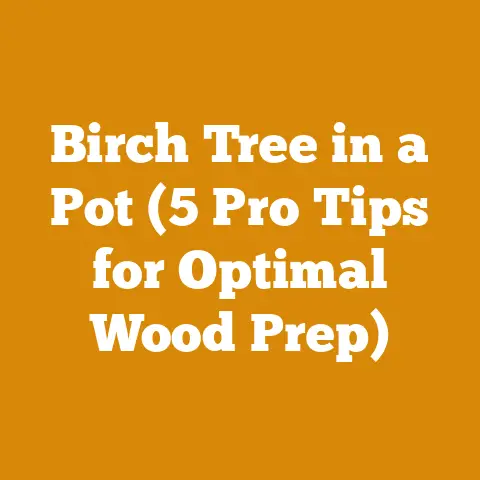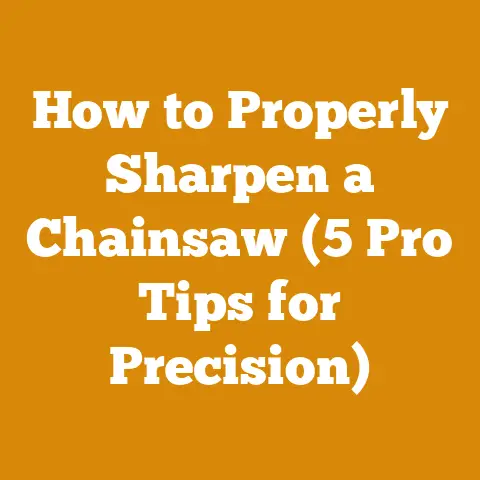Does Epsom Salt Kill Trees? (Stump Killing Tips for Arborists)
As someone deeply involved in the world of wood processing, logging, and firewood preparation for over two decades, I’ve seen my fair share of tree stumps. And I know that dealing with them can be a real pain. While there are many methods to get rid of these stubborn remnants, one question that often pops up is: “Does Epsom salt kill trees?”
The short answer is yes, Epsom salt can kill trees and more specifically, help decompose stumps. However, it’s not a magic bullet. There are more effective and environmentally conscious ways to tackle stump removal, especially if you’re aiming for speed and minimal impact on the surrounding soil. In my experience, the best option is a combination of physical removal (chainsaw work) followed by natural decomposition aided by nitrogen-rich additives and, if necessary, a targeted herbicide application. This approach offers the most control, efficiency, and reduces the risk of unintended consequences.
Let’s dive into the details of using Epsom salt, its pros and cons, and, most importantly, explore the most effective methods for stump removal, drawing from my years of hands-on experience.
Understanding the Epsom Salt Method
What is Epsom Salt?
Epsom salt is magnesium sulfate, a naturally occurring mineral compound. It’s commonly used in gardening to provide magnesium, which is essential for plant growth. However, in high concentrations, it can disrupt a tree’s water and nutrient uptake, leading to its demise.
How Epsom Salt Kills Trees and Stumps
The theory behind using Epsom salt to kill a tree or stump is that the high concentration of magnesium sulfate draws moisture out of the wood, dehydrating it. This creates an environment that’s unfavorable for the tree’s survival and encourages the growth of fungi that decompose the wood. In essence, you’re accelerating the natural rotting process.
Is It Effective? My Experience and Insights
In my experience, Epsom salt is moderately effective for killing trees and stumps, but it’s not always the fastest or most reliable method. It works best on smaller, freshly cut stumps. Larger stumps, especially those from hardwood trees, are more resistant to the effects of Epsom salt.
I remember a project where I was clearing a small area of my property for a firewood storage shed. I had a few small oak stumps that I wanted to get rid of. I tried the Epsom salt method on one of them, and it took almost a year for the stump to completely decompose. On the other hand, a similar-sized pine stump treated with a nitrogen-rich fertilizer and kept consistently moist rotted away much faster – in about six months.
This experience taught me that the type of wood, the size of the stump, and the surrounding environmental conditions all play a significant role in the effectiveness of the Epsom salt method.
A Step-by-Step Guide to Using Epsom Salt on Stumps
If you’re going to try the Epsom salt method, here’s a step-by-step guide based on my experience:
Step 1: Gather Your Supplies
- Epsom salt (available at most garden centers or pharmacies)
- Drill with a large drill bit (at least ½ inch)
- Water
- A bucket or container for mixing
- A tarp or plastic sheet (optional, to protect surrounding plants)
Step 2: Prepare the Stump
- Cut the stump as close to the ground as possible using a chainsaw. Ensure you are wearing appropriate PPE: safety glasses, ear protection, gloves, and chainsaw chaps. I personally use a Stihl MS 261 C-M chainsaw for this type of work, as it’s powerful yet maneuverable. The bar length I typically use is 18 inches.
- Drill several deep holes into the top of the stump. The more holes you drill, the better the Epsom salt will penetrate the wood. Aim for holes that are at least 8-12 inches deep. I usually drill holes about 2-3 inches apart.
- Drill holes around the sides of the stump as well, angling them downwards. This will help the Epsom salt reach the roots.
Step 3: Apply the Epsom Salt
- Mix the Epsom salt with water to create a saturated solution. The ratio isn’t critical, but aim for a thick, slurry-like consistency. I usually use about 1 cup of Epsom salt per gallon of water.
- Pour the Epsom salt solution into the holes you drilled. Fill them to the top.
- If you have a very large stump, you can also spread Epsom salt around the base of the stump.
Step 4: Cover and Wait
- Cover the stump with a tarp or plastic sheet to prevent rain from washing away the Epsom salt and to keep the area moist.
- Wait. This is the most important part. It can take several months to a year (or even longer) for the stump to decompose completely, depending on the size of the stump and the type of wood.
Step 5: Repeat (If Necessary)
- Check the stump periodically. If the Epsom salt solution has been absorbed or washed away, reapply it.
- You may need to repeat the application several times over the course of several months.
My Tips for Success:
- Freshly Cut Stumps Work Best: Apply the Epsom salt as soon as possible after cutting down the tree.
- Maximize Contact: The more surface area the Epsom salt has to work with, the better. Drill plenty of holes.
- Keep It Moist: Moisture is essential for the decomposition process. Keep the stump covered and reapply the Epsom salt solution as needed.
The Drawbacks of Using Epsom Salt
While Epsom salt can be effective, it’s important to be aware of its drawbacks:
- Slow Process: It can take a very long time for a stump to decompose completely using this method.
- Not Always Effective: It may not work on all types of trees, especially hardwoods.
- Environmental Concerns: While Epsom salt is generally considered safe, excessive use can alter the soil’s pH and potentially harm nearby plants.
- Aesthetic Issues: A dead, rotting stump isn’t exactly the most attractive thing in your yard.
The Best Alternatives to Epsom Salt for Stump Removal
In my experience, there are several methods that are more effective and efficient than using Epsom salt for stump removal:
1. Physical Removal (The Most Direct Approach)
This is my preferred method, especially for larger stumps or when I need the stump gone quickly. It involves physically digging out the stump and roots.
Tools You’ll Need:
- Chainsaw: For cutting the stump close to the ground and sectioning larger roots.
- Pickaxe: For breaking up the soil around the stump and roots.
- Shovel: For digging and removing soil.
- Root Saw or Reciprocating Saw: For cutting smaller roots.
- Axe: For chopping through stubborn roots.
- Heavy-Duty Gloves: To protect your hands.
- Eye Protection: Safety glasses are a must.
- Ear Protection: Especially when using power tools.
- Leverage Tools (Optional): A pry bar or come-along can be helpful for dislodging large roots.
Steps for Physical Removal:
- Clear the Area: Remove any rocks, debris, or vegetation around the stump.
- Dig Around the Stump: Dig a wide trench around the stump, exposing the main roots.
- Cut the Roots: Use a root saw, reciprocating saw, or axe to cut the roots. Start with the larger roots and work your way down to the smaller ones.
- Leverage the Stump: Once you’ve cut most of the roots, use a pry bar or come-along to try to dislodge the stump.
- Remove the Stump: With the roots cut and the stump loosened, you should be able to lift it out of the ground. You may need help with larger stumps.
- Fill the Hole: Fill the hole with soil and compact it.
My Tips for Physical Removal:
- Sharp Tools are Essential: Make sure your chainsaw, axe, and saws are sharp. This will make the job much easier and safer.
- Work Smart, Not Hard: Use leverage to your advantage. A pry bar or come-along can save you a lot of effort.
- Don’t Be Afraid to Ask for Help: Removing a large stump can be a two-person job.
Case Study: Removing a Large Oak Stump
I once had to remove a massive oak stump from a client’s property. The stump was about 4 feet in diameter and had a complex root system. I started by using my Stihl MS 462 R C-M chainsaw (a larger, more powerful model than the MS 261 I mentioned earlier – I typically use a 25-inch bar on this one) to cut the stump as close to the ground as possible. Then, I spent several hours digging around the stump, exposing the roots. I used a combination of a pickaxe, shovel, and root saw to cut the roots. The largest roots were nearly a foot in diameter, so I had to use a chainsaw to cut through them.
After several days of hard work, I finally managed to remove the stump. It was a challenging job, but the satisfaction of seeing that stump gone was immense.
2. Stump Grinding (A Faster, More Efficient Option)
Stump grinding is a faster and more efficient way to remove stumps than physical removal. It involves using a specialized machine called a stump grinder to grind the stump into small chips.
How Stump Grinding Works:
A stump grinder has a rotating cutting wheel with teeth that chip away at the wood. The operator moves the grinder back and forth across the stump, gradually grinding it down to below ground level.
Benefits of Stump Grinding:
- Fast: Stump grinding is much faster than physical removal.
- Efficient: It can grind stumps of any size and type of wood.
- Less Labor-Intensive: It requires less physical effort than physical removal.
- Minimal Disruption: It doesn’t disturb the surrounding soil as much as physical removal.
Drawbacks of Stump Grinding:
- Cost: Stump grinding machines can be expensive to rent or purchase. Hiring a professional stump grinding service can also be costly.
- Safety: Stump grinding can be dangerous if not done properly. It’s important to wear appropriate safety gear and follow the manufacturer’s instructions.
- Mess: Stump grinding creates a lot of wood chips. You’ll need to dispose of them properly.
My Experience with Stump Grinding:
I’ve used stump grinders on several projects, and I’ve always been impressed with their speed and efficiency. I remember one project where I had to remove about a dozen small to medium-sized stumps from a client’s property. I rented a stump grinder from a local equipment rental company, and I was able to grind all the stumps in a single day.
Choosing a Stump Grinder:
There are two main types of stump grinders:
- Walk-Behind Stump Grinders: These are smaller, more maneuverable grinders that are suitable for smaller stumps and tight spaces.
- Tow-Behind Stump Grinders: These are larger, more powerful grinders that are suitable for larger stumps.
When choosing a stump grinder, consider the size and type of stumps you’ll be grinding, as well as the size of the area you’ll be working in.
3. Natural Decomposition (The Patient Approach)
If you’re not in a hurry, you can let nature take its course and allow the stump to decompose naturally. This is the most environmentally friendly option, but it can take several years for a stump to completely rot away.
How to Speed Up Natural Decomposition:
- Keep the Stump Moist: Moisture is essential for decomposition. Water the stump regularly, especially during dry periods.
- Apply Nitrogen-Rich Fertilizer: Nitrogen helps to break down the wood. Apply a high-nitrogen fertilizer to the stump. I’ve had success with urea-based fertilizers.
- Cover the Stump: Covering the stump with a tarp or plastic sheet will help to retain moisture and warmth, which will speed up decomposition.
- Drill Holes: Drilling holes in the stump will allow moisture and fungi to penetrate the wood more easily.
- Add Compost or Manure: Adding compost or manure around the base of the stump will provide additional nutrients and microorganisms that will help to break down the wood.
My Tips for Natural Decomposition:
- Patience is Key: Don’t expect the stump to disappear overnight. It will take time for it to decompose completely.
- Create a Favorable Environment: Keep the stump moist, provide nutrients, and protect it from the elements.
- Consider Mushroom Inoculation: You can inoculate the stump with mushroom spores to encourage fungal growth. This can help to speed up decomposition.
Case Study: Using Nitrogen to Accelerate Decomposition
I had a large silver maple stump in my backyard that I wanted to get rid of. I didn’t want to spend the time and effort to physically remove it, and I didn’t want to rent a stump grinder. So, I decided to let it decompose naturally.
I started by drilling several holes in the stump and applying a high-nitrogen fertilizer. I then covered the stump with a tarp to retain moisture. I watered the stump regularly and reapplied the fertilizer every few months.
Over the course of about two years, the stump gradually rotted away. It wasn’t a quick process, but it was a relatively easy and environmentally friendly way to get rid of the stump. I even managed to cultivate some oyster mushrooms on the stump, which was a nice bonus!
4. Chemical Stump Removers (Use with Caution)
Chemical stump removers contain chemicals that accelerate the decomposition of wood. The most common active ingredient in these products is potassium nitrate.
How Chemical Stump Removers Work:
Potassium nitrate is a strong oxidizer that helps to break down the lignin in wood. Lignin is the complex polymer that gives wood its strength and rigidity. By breaking down the lignin, chemical stump removers make the wood more susceptible to fungal attack.
Using Chemical Stump Removers:
- Drill Holes: Drill several deep holes into the stump.
- Pour in the Chemical: Pour the chemical stump remover into the holes.
- Add Water: Add water to the holes to help the chemical penetrate the wood.
- Wait: Wait several weeks or months for the stump to decompose.
- Burn (Optional): Once the stump is thoroughly saturated with the chemical, you can burn it. The potassium nitrate will act as an oxidizer, helping the wood to burn more easily.
My Cautions About Chemical Stump Removers:
- Safety: Chemical stump removers can be hazardous. Follow the manufacturer’s instructions carefully and wear appropriate safety gear.
- Environmental Concerns: Chemical stump removers can contaminate the soil and water. Use them sparingly and avoid spilling them.
- Effectiveness: Chemical stump removers are not always effective, especially on large or dense stumps.
- Burning: Burning a stump can be dangerous and may be prohibited in some areas. Check your local regulations before burning a stump.
A Safer Alternative to Chemical Stump Removers: Targeted Herbicide Application
While not technically a “stump remover,” a targeted herbicide application is often the most effective way to kill the remaining root system and prevent regrowth, particularly for trees known for their suckering abilities (like aspen or black locust).
How it Works:
- Cut the Stump Low: As with other methods, start by cutting the stump as close to the ground as possible.
- Apply Herbicide Immediately: Within minutes of cutting the stump, apply a systemic herbicide containing glyphosate or triclopyr to the freshly cut surface. These herbicides are absorbed by the plant and transported throughout the root system, killing it.
- Choose the Right Herbicide: Glyphosate is effective on a wide range of trees, while triclopyr is particularly effective on woody plants. Always read and follow the manufacturer’s instructions carefully.
- Targeted Application is Key: Apply the herbicide directly to the cambium layer (the thin layer of tissue just inside the bark) of the stump. This will ensure that the herbicide is absorbed effectively. Avoid spraying the surrounding vegetation.
My Recommendations for Herbicide Application:
- Use a Paintbrush or Applicator: A small paintbrush or a specialized stump treatment applicator can help you apply the herbicide precisely.
- Apply on a Calm Day: Avoid applying herbicide on windy days to prevent drift.
- Wear Protective Gear: Wear gloves, eye protection, and long sleeves when applying herbicide.
- Consider the Season: Herbicide application is most effective during the growing season when the tree is actively transporting nutrients.
Important Considerations for All Stump Removal Methods:
- Tree Species: The type of tree will affect the ease of stump removal. Softwood trees like pine and fir are generally easier to remove than hardwood trees like oak and maple.
- Stump Size: Larger stumps will require more time and effort to remove.
- Root System: Some trees have shallow, spreading root systems, while others have deep, taproot systems. The type of root system will affect the removal method.
- Soil Type: The type of soil will affect the ease of digging and removing the stump. Sandy soil is easier to dig than clay soil.
- Regulations: Check your local regulations before removing a stump. Some areas may have restrictions on stump removal methods or require permits.
Safety First: Chainsaw and Wood Processing Safety
No discussion about stump removal is complete without emphasizing safety. Chainsaws and other wood processing tools can be dangerous if not used properly.
Here are some essential safety tips:
- Read the Manual: Always read and understand the owner’s manual for any tool you’re using.
- Wear Appropriate Safety Gear: Wear safety glasses, ear protection, gloves, chainsaw chaps (when using a chainsaw), and sturdy boots.
- Inspect Your Tools: Before each use, inspect your tools for damage or wear.
- Keep Your Tools Sharp: Sharp tools are safer and more efficient.
- Work in a Safe Area: Clear the area of any obstacles or hazards.
- Be Aware of Your Surroundings: Pay attention to what’s happening around you.
- Take Breaks: Don’t work when you’re tired or distracted.
- Never Work Alone: It’s always a good idea to have someone nearby in case of an emergency.
- Know Your Limits: Don’t attempt to do something that you’re not comfortable with.
Chainsaw Specific Safety:
- Use Proper Cutting Techniques: Learn the proper techniques for felling trees and cutting wood.
- Be Aware of Kickback: Kickback is a sudden, uncontrolled movement of the chainsaw bar that can cause serious injury.
- Maintain a Firm Grip: Keep a firm grip on the chainsaw with both hands.
- Never Cut Above Shoulder Height: Cutting above shoulder height is dangerous and can increase the risk of kickback.
- Don’t Cut with the Tip of the Bar: The tip of the bar is the most likely area to cause kickback.
Strategic Insights: Integrating Stump Removal into Wood Processing
Stump removal isn’t just about getting rid of an eyesore. It can be an integral part of your overall wood processing strategy.
Here are some strategic insights to consider:
Here are some practical next steps:
- Assess Your Situation: Determine the size, species, and location of the stump.
- Choose a Method: Choose the stump removal method that’s best suited to your situation, considering your budget, time constraints, and environmental concerns.
- Gather Your Supplies: Gather the necessary tools and materials.
- Follow the Instructions: Follow the instructions carefully and take all necessary safety precautions.
- Enjoy the Results: Once the stump is removed, enjoy your newly cleared space.
Remember, stump removal can be a challenging but rewarding task. With the right knowledge, tools, and techniques, you can successfully remove stumps and create a more beautiful and functional landscape. And while Epsom salt might be a tempting option, consider the alternatives I’ve discussed for a faster, more effective, and potentially more environmentally sound solution. Good luck!






